Hello Everyone!
Greetings from McMurdo Station!
1. More about McMurdo Station
The station I am at – here in Antarctica – is McMurdo Station. It is the largest station in Antarctica (see photo with Observation Hill in the background). It holds roughly up to 1100 people, although this year there are a bit fewer – more like 700 to 850 or so. The station was established back in the 1956-1957 during the International Geophysical Year (IGY). This is the southernmost place you can sail a ship in the world. The folks who are working here are not deployed for more than a year at a time. No families/children – just those who help support the science mission of the US Antarctic Program, as either support staff, or the science groups leading science efforts. The station is staffed year-round, however, there are much fewer who winter-over and stay to work on projects or prepare for the next summer science “field season” (typically 150 give or take a few winter-over). The station has all the things you need just like you have at home: A hospital, a fire department, places to live (dorms), eat (the galley – as this was historically a Naval station), work (in my case, the Crary Science and Engineering Center), waste management, etc.
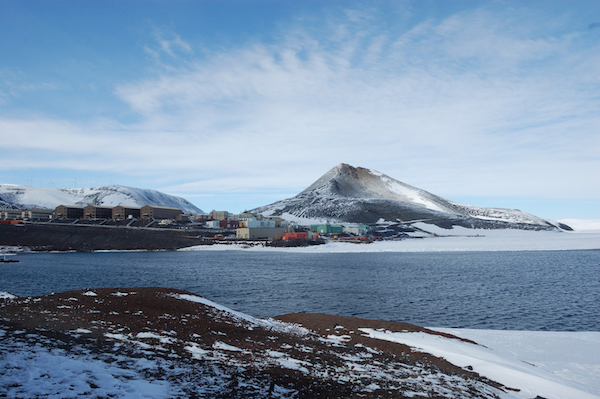 McMurdo with Observation Hill in the background 2. Weather – and more cancellations
This week has been filled with stormy weather (see attached). We had a storm here in McMurdo, and now that it has moved on, the weather isn’t good at the AWS sites we hope to visit. Hopefully we’ll have a break in the coming days. This is a difficult situation as we are flying long distances to visit the AWS sites, and have to have weather good at the AWS site, at a refueling site, and here in McMurdo is a tall order!
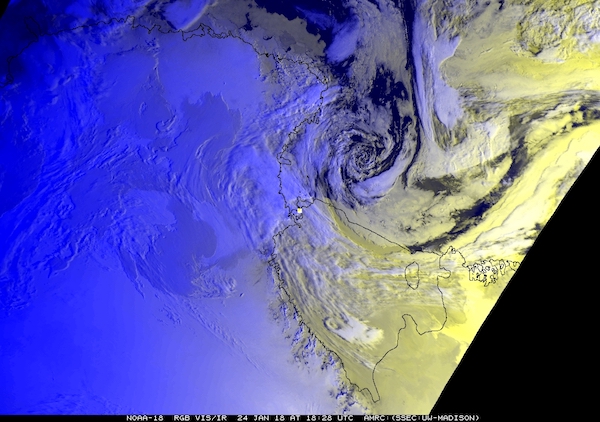 Antarctic storm 3. Whales! (and a Skua)
A few days back, we got to see a minke whale in the open water cut open but the icebreaker! It was a fun to see whales – my very first time here after 10 deployments over the last 22 years. I’m not always here during a time when there is open water. Much of the sea life really does cling to the edge of the sea ice. I also got a photo of a skua – which is a lot like a seagull.
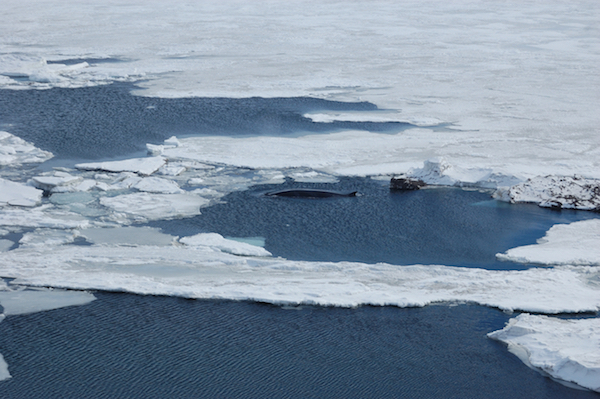 Minke Whale 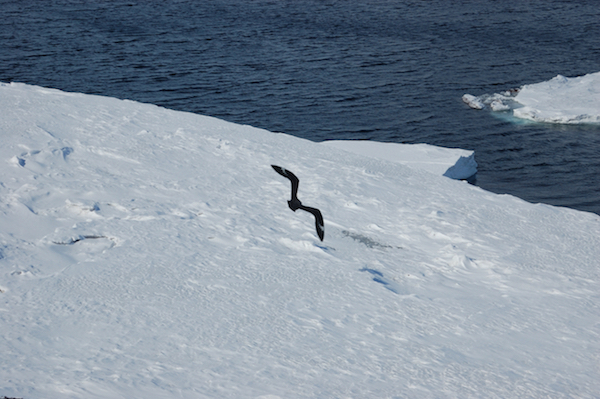 Skua! 4. Resupply Vessel Arrives!
Speaking of ships, the Ocean Giant – the resupply vessel has just arrived on station! This next week we will see McMurdo Station, which is already a 24-hour operation, become super busy with the offload and on load of cargo and supplies for the station. It’s an impressive operation involving a segment of the US Navy, the New Zealand Defense Forces, personnel on the vessel along with the support staff (NSF’s contractor Antarctic Support Contract) already here at McMurdo Station.
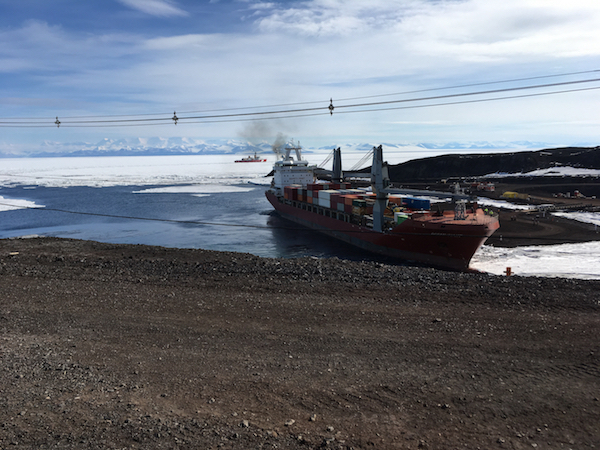 Ocean Giant vessel arrives More next time!!
Best Regards,
Matthew
The day we went to Austin AWS, the POLENET crew arrived at WAIS. There are 8 of them, so they definitely made an immediate impact on camp life in that they nearly doubled the population! They also take up a lot of space in our “science mod,” as evidenced by the following pictures.
 The science mod, before the POLENET infestation.
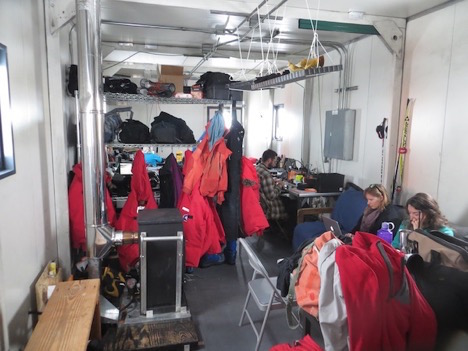 The science mod, after the POLENET infestation.
It took some coping, but Marian and I eventually accepted that fact that we needed to share our space with them. And in all seriousness, POLENET is a great crew to work alongside, so we can’t complain.
The day after POLENET arrived (4 Jan), they got priority for using the Twin Otter and ended up flying to one of their sites. Marian and I took this opportunity to go to Kominko-Slade AWS, a 5-minute snowmobile ride away, to raise it. It had been several years since it was last raised, so we were prepared to do a lot of digging to unbury the 2 boxes of batteries (~150 pounds each) for the power system. This AWS has some extra instrumentation (hence an extra power system box), so we knew we had a long day ahead of us. The weather was great that day, with light winds and sunny skies. As it turns out, it took us two days to finish the work, but we lucked out in that the weather was good both days and even better on the second day.
 Kominko-Slade on arrival, with our snowmobile and Marian in the background.
After we arrived, we recorded the heights of all the instruments and noted ones that were buried. The ADG and solar radiation sensor boom is buried just below the surface, and you may see it extending out to the left from the tower. Then we started digging out the buried instruments and power system.
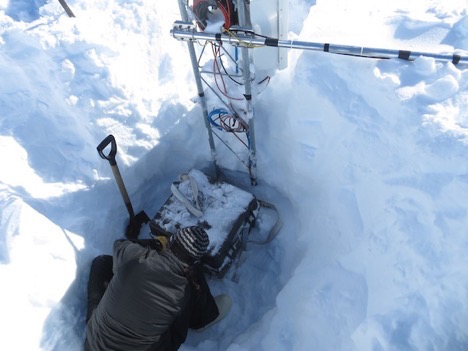 Marian working on freeing the top battery box (they were stacked). 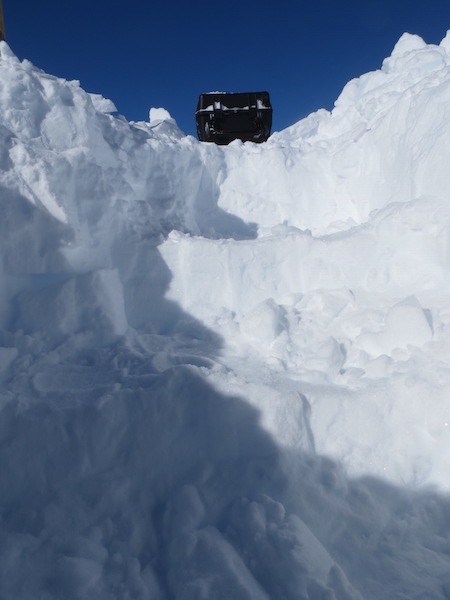 The view from the hole. I’m standing atop the second power box. We (mostly Marian) dug out a staircase to more easily raise the boxes.
We reached the second power system, but at that point it was getting to be lunchtime in town so we decided to wait with raising the second one until after we fueled ourselves up. That’s another perk of working at KMS; we got a hot lunch!
After the delicious grub, thanks to the awesome camp chef Zach, we got back to Kominko-Slade and raised that second power box. We then began removing instrumentation from the tower to prep for putting on a new tower section. We tried the troublesome 7-footer that we had attempted to use at Kathie and Austin, but as we expected, it didn’t fit on Kominko-
Slade either. We attached a 5-foot tower section instead. The remainder of the day, until around dinner time, we worked on reinstalling the instrumentation and filling in the pit we had dug. We resigned ourselves to finishing our work the following day and heading back to town for the night.
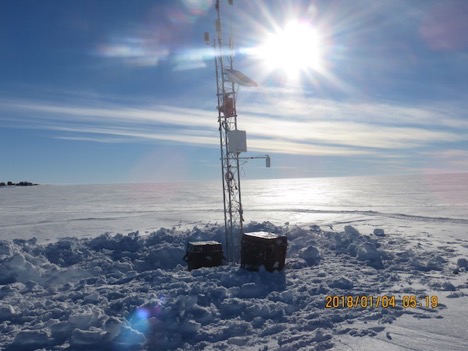 Kominko-Slade, as we left it at the end of our first day there. The next day, 5 Jan, Marian and I went back out to Kominko-Slade. It worked out in that the weather was not good at any of our sites to fly to and the weather was great at WAIS!
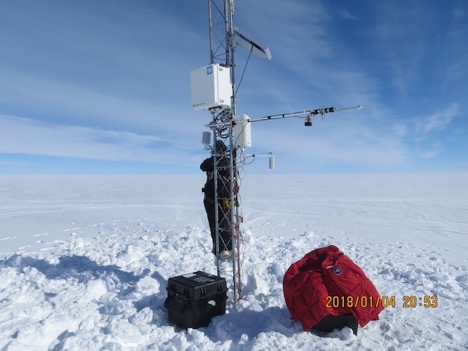 Marian on the tower. The rest of the work we had to do went very smoothly and within a couple comfortable hours we were finished. Kominko-Slade is safe from a snow burial for another several years!
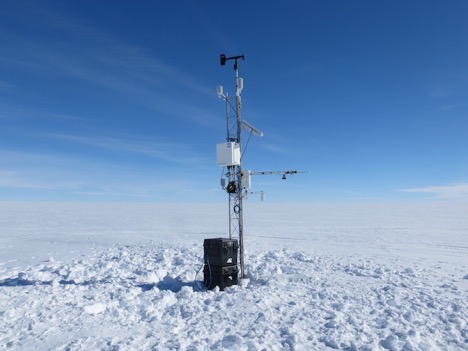 The newly-raised Kominko-Slade AWS.
Cheers,
Dave Mikolajczyk
Harry AWS, 2 January
On 2 January, we took an Otter to Harry AWS. For this site, we wanted to install a boom with an ADG sensor and move the solar radiation sensor currently installed at Harry onto said boom. The pressure sensor has been acting oddly at times, so we wanted to check the wiring on that. We also wanted to raise the station if needed. Before going, we weren’t sure if we needed to add another tower section or not. As it turned out, we did not need to add a tower section! A pleasant surprise. The battery box was only buried a few inches, so digging that up was easy.
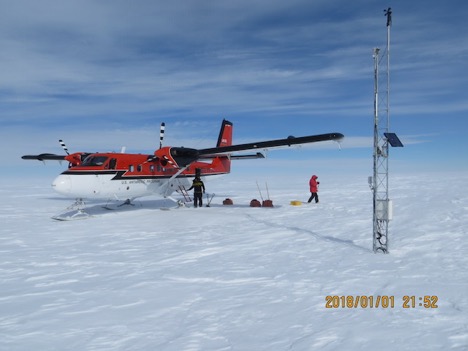 Harry AWS upon arrival. It’s plenty tall!
It was quite windy for the duration of our visit, with sustained winds of 15 to 20 knots. Fortunately for us, the temperature was quite warm (around -7 C) so despite the winds, it was still bearable working conditions.
Marian and I dug out the power system then worked on doing any necessary maintenance to instruments on the tower. There wasn’t any issue found with the pressure sensor, so we are unsure why it would occasionally have bad readings. We raised the lower temperature sensor, enclosure, and solar panel. We installed the boom with the ADG and solar radiation sensor as well. Troy noticed that the station was leaning slightly, so we used a cargo strap to function as a guy wire and hopefully prevent any further leaning.
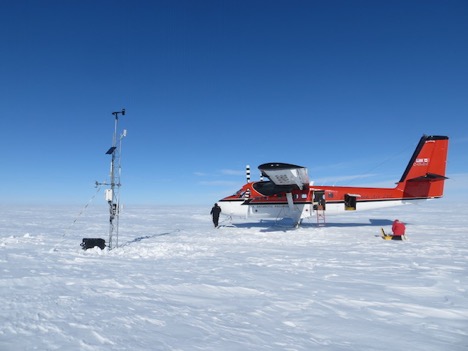 Harry after servicing. The Twin Otter always spices up the picture. Austin AWS, 3 January
Flying two days in a row! We were very excited to get out to Austin as this was our highest priority site. We stopped receiving transmissions from the site in March 2017, and our hypothesis was that was caused by a failure with the fuse box in the power system which then shut the AWS down. Before the transmission failure, we noticed from the ADG measurements that the station was getting buried very quickly. We knew that we had a long day of digging ahead of us, but if we couldn’t visit Austin this year we were worried that it would get buried by the next time we could visit.
Austin is also a tough site because it is one of the furthest AWS from WAIS which means more time flying, more fuel, and more of a chance that the weather could turn either at Austin or at WAIS, preventing us from going. The forecast at Austin for that day called for clear skies but fog in the vicinity. Another one of our sites, Evans Knoll, was clear, so our plan of action was to fly to Austin and if conditions were too poor, we would head to Evans Knoll. As it turned out, the weather was gorgeous at Austin for our entire visit; clear skies and low winds (and relatively warm temperatures around -10 C).
 Austin AWS upon arrival. Austin was as buried as we were fearing, but we were very happy that the enclosure was still above the surface. This allowed us to check the datalogger right away, but as expected, it was not powered on.
We began digging down to the power system buried about 8 feet below the enclosure. We also needed to dig out the ADG/solar radiation sensor boom and the lower temperature sensor that was mounted on the opposite side of the enclosure.
 The two pits at Austin, with the power system pit in the foreground. This may be where we just reached the top of the box. After a little over an hour, enough had been dug out for Marian and I to start removing the instrumentation and install the new tower section. As opposed to Kathie, we were prepared to use a cargo strap to help us get the tower section on. And it worked very well. Given the amount of accumulation at Austin, we decided to put a 7-foot and a 5-foot tower section on, to raise it 12 feet. This will hopefully make the next visit a little easier, as the only thing that will hopefully be buried is the power system.
About halfway through, we were welcomed with an unexpected visitor… a skua!

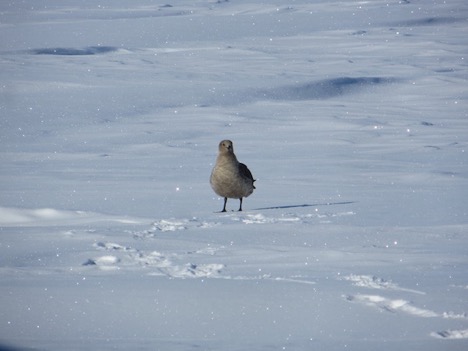
It’s always strange seeing wildlife in the middle of the continent. There’s almost literally nothing but snow and ice for hundreds of miles. It’s amazing that an animal could make it this far. We think that it got here by accident, though, and that it probably won’t make it back to the coast, or a place where it can find food. We were hoping for the best for the little guy!
After that interesting distraction, we finished up with the station raise to make Austin look like new again.
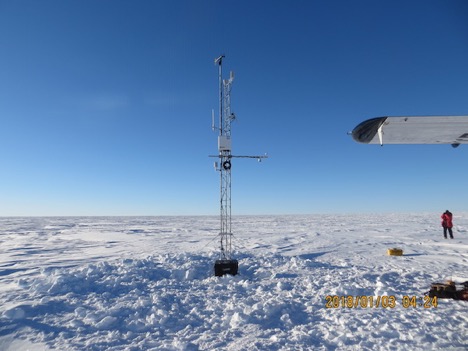 Austin after the raise. One bummer that we didn’t learn about until a couple days after our visit is that the real-time transmissions are not working. We are not sure whether it’s simply a loose cable connection or if there is something wrong with the Argos transceiver. We did verify that the station was powered on and collecting data when we left, so at least we will have the data card collecting the data in the meantime.
Also, as a bonus, right before we left we noticed some fata morgana on the horizon. This is a mirage effect caused by cold air at the surface. It tends to make things look taller than they are. You can see this effect right on the edge of the horizon in the picture below.
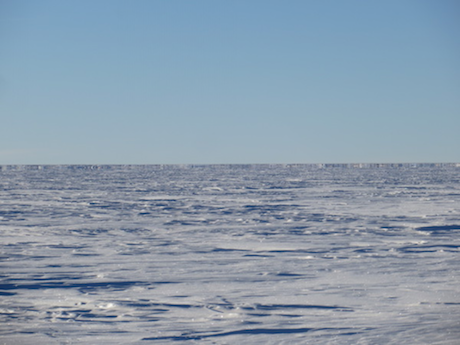 The fata morgana at Austin. You may notice the little bit of distortion along the horizon. Cheers,
Dave Mikolajczyk
It has been a while since I’ve written a post, and that’s with good reason. Marian and I have been very productive in the past week and a half, flying to 4 of our 7 Otter sites and completing the work at Kominko-Slade, the AWS near WAIS camp. We went on a stretch of 4 straight days of work on 3 AWS, and 4 AWS completed in 5 days, and 5 AWS in 7 days. That’s a pretty darn good ratio of AWS per work days! Given that, I haven’t had much time to write up a blog post. Now it’s Sunday, 07 Jan, so I have some time to get some updates written down. I’ll split up the posts here to make things a little bit more palatable, rather than cramming everything into one long post.
Here’s a list of the sites we’ve serviced thus far:
29 Dec: Kathie
31 Dec: Bear Peninsula
02 Jan: Harry
03 Jan: Austin
04 and 05 Jan: Kominko-Slade
This post will cover our work at Kathie and Bear Peninsula.
On 29 December, Marian and I visited our first site out of WAIS, Kathie AWS. We were ecstatic to get to this site only two days after getting to camp, especially since it was 2nd highest on our priority list. Back in January 2016, this site was installed by Lee and Carol. This is the first time we’ve revisited it, so we were very curious to see how the AWS was holding up, especially since our acoustic depth gauge (ADG) measurements indicated that there was a fair amount of snow accumulation. We were certain we were going to need to raise it with another tower section as the ADG measurements implied a lot of digging was needed. As shown in the picture below, the power system and the electronics enclosure were buried.
 Kathie AWS upon arrival After we got heights of the instruments, we began digging out the buried instrumentation. When the cables on the tower were free enough with slack, I could begin removing some of the instruments while Marian continued digging. When she dug far enough to expose the enclosure, I went down to remove the data card from the datalogger and power down the station.
 Me in the pit. I’m standing on the battery box, so we had to dig about an additional 2 feet to free it. That made it a pit about 8 feet deep.
Once I removed the upper instrumentation (aerovane, upper temperature sensor), Marian and I climbed up the tower to start installing the new tower section. To put it bluntly, we had a devil of a time getting the tower section on and spent about an hour trying to do so. We brought two 7-foot sections in case one gave us trouble. As it turned out, one new tower fit slightly better than the other, but one of the poles on the existing tower was bowed out about a quarter of an inch. To solve this issue, we tried hitting it in with a sledge hammer (probably over 200 times). This got the pole to within about 1/16 of an inch of fitting, but the new tower still wouldn’t slide on. We were getting exhausted. Then Brandon had a brilliant idea: use a small cargo strap to tie around the old tower, then tighten it to synch the poles together. We tried this, and the new tower slid on after only a few cranks on the cargo strap. What a relief! Marian and I could finally start reinstalling the instrumentation on the tower.
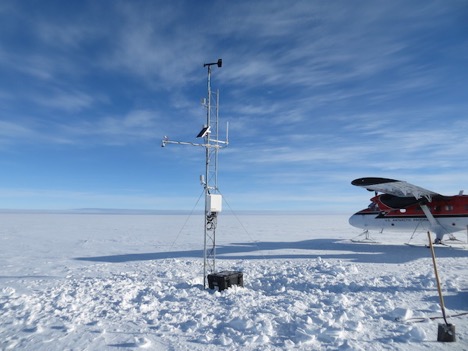 Kathie after a successful raise.
On New Year’s Eve, Marian and I flew to Bear Peninsula. We had plenty of extra room on the plane, so we brought along two camp staff, Brian (heavy equipment operator) and Gus (weather observer). Bear Peninsula had not been visited since it was installed in November 2011. According to the data we’ve been receiving from it, it has been running smoothly for those 6 years. Of course, there are issues that the data alone can’t reveal, so it was very valuable to get to the site (if not to fix the issues, then to at least get more pictures of the site!).
Near our site, there is a bluff that a lot of snow petrels (big white birds) call home. We flew by the bluff, and I could see several of the birds flying around. Unfortunately, I couldn’t get a good picture of the birds themselves.

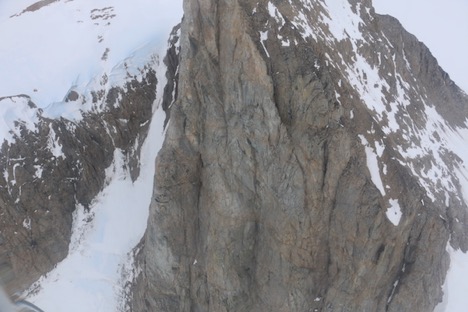

After we landed on the peninsula, in a snow field, we had about a 10 minute hike up to our AWS. It was icy up the hill until we reached the rocky area where our site is located.
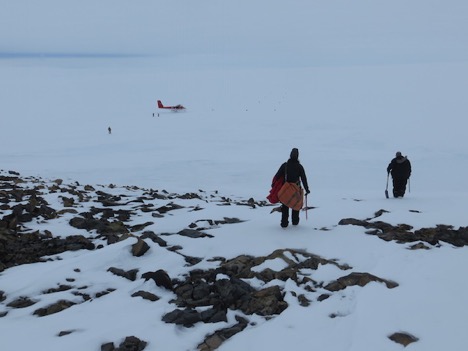 The hike (on our way back actually), with the beginning of the rocky ground in the foreground and the icy hill just beyond it. Luckily there was about an inch of snow on the ice which provided enough grip for us to make it much less treacherous.
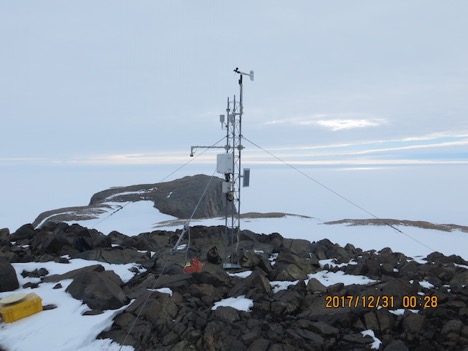 Bear Peninsula AWS upon arrival. The bluff with the snow petrels is in the background.
Bear Peninsula gets some pretty high winds at times. It’s impressive that the aerovane at the top of the tower hadn’t broken off. It was still reporting wind speed and direction, but upon further inspection, the aerovane doesn’t turn properly. This means the direction values are incorrect. This also affects wind speed values because the instrument has a difficult time turning into the wind to get good values when the wind speed is too low. On our next visit, we will need to replace this instrument.
The Gill radiation shields for the temperature and relative humidity sensors needed some fixing as well. Each shield has 3 long screw rods to hold the multiple plates together. Each shield, however, was missing a rod and one was loose. I tightened those and prevented any further damage as best as I could.
 The damaged Gill radiation shield for the temperature sensor. That is not normal!
Another issue we found was that one of the three guy wires was getting worn down by a large rock near it. The guy wire isn’t rubbing against the rock on its own, but in high winds it wobbles enough to rub against the rock. It’s been worn fairly thin at that point, so we used a cargo strap to temporarily hold the guy wire in place, in case the guy wire breaks before we can replace it on our next visit.
 The guy wire, the rock, and the cargo strap.
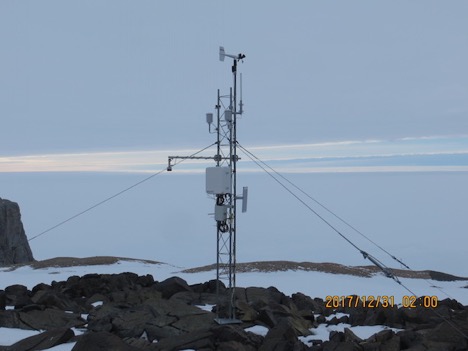 Bear Peninsula AWS after servicing.
Overall, the site visit went well. Hopefully things don’t get too damaged until we can visit it again, which will hopefully only be in a year.
Cheers,
Dave Mikolajczyk
Marian and I arrived at WAIS today. But not before trying on three separate days, two of which were before the Christmas break. We first tried to fly to WAIS on Friday, 22 Dec, but we were a backup to the primary mission, and the primary mission flew to South Pole. The next day, we were again on the schedule but got canceled due to weather. Since the Christmas holiday break in town was on 24 and 25 Dec, that meant we wouldn’t try to fly to WAIS on those days and would instead spend Christmas in McMurdo. While it would have been nice to get to WAIS sooner, it was still nice to enjoy the Christmas festivities in McMurdo.
For our third failed attempt at flying to WAIS, on Tuesday, 26 Dec, we got onto the Herc and were ready to go, but there turned out to be a gear issue with one of the skies. We taxied for about 20 minutes before we were told to depart the Herc and wait at the airfield until they could unload the cargo from the original plane and load it on another Herc. As it turned out, that was taking too long because they had to de-fuel the injured Herc, which is a slow process. Due to the delay, we were canceled because it would push the schedule for future flights in the week too far back.
Then, today we finally made it to WAIS! As it turns out, this was the original date we had planned to get to WAIS, so we’re actually right on schedule. The weather today is gorgeous, with clear blue skies and low winds.
 WAIS field camp, nary a cloud in sight The field camp is smaller than in years past. Marian and I make 12 people at camp, with the rest being the Twin Otter crew (2 pilots and an engineer) and the camp staff (manager, cook, mechanics, observer, etc). We took the place of two carpenters, who went back to McMurdo on the Herc that dropped us off. Because they left, we were able to occupy their Arctic Oven tent and not have to set up our own. What a deal! Our tents are in a section of camp known as tent city, where everyone sleeps.
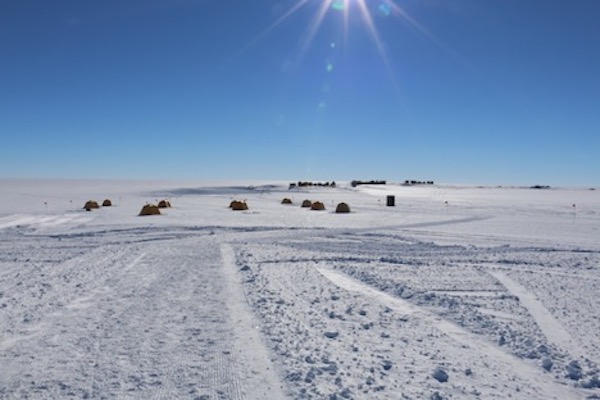 Tent city, as viewed from town. Again, nary a cloud…. Cheers,
Dave Mikolajczyk
Hello Everyone!
This past few days has been busy! Here’s the activities over the last few days:
1. Visiting Linda AWS site
Late last week, we got to visit another automatic weather station (AWS) site – Linda AWS. It’s about a 30 to 40-minute helicopter flight out to Linda. I was joined by my colleague Andy along with a helper from the McMurdo fire department. He spent his day off with us to help out, and get the chance to see a bit of Antarctica. While the photos don’t show it, it was a mighty windy day, with winds constant at 20 to 25 miles per hour. Some snow was blowing around, which also made it a bit more of a challenge. On the return trip, we were able to catch a great view of Mt. Erebus – with a lenticular cloud covering it, and McMurdo Station all in the same view. The trip was an overall success with the station running well.
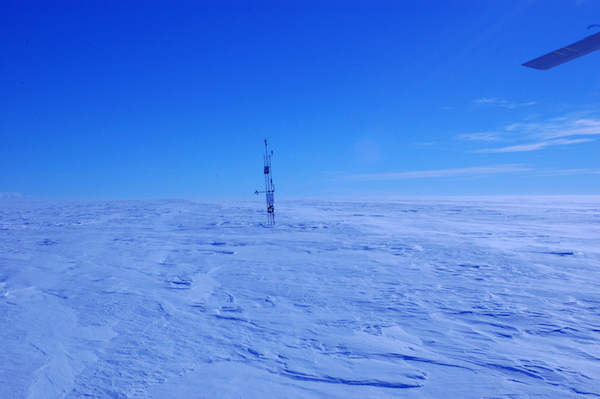 Linda AWS viewed from the helicopter 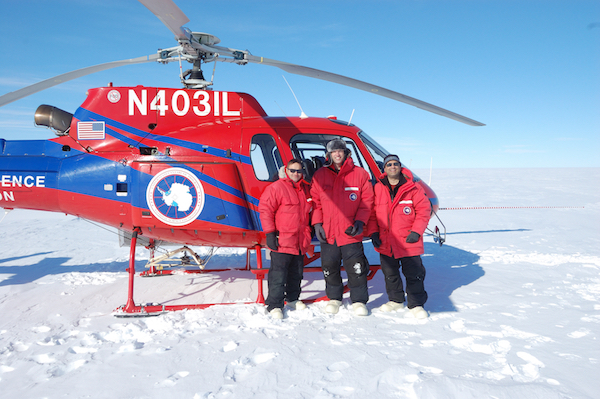 Art, Andy, and Matt from left to right 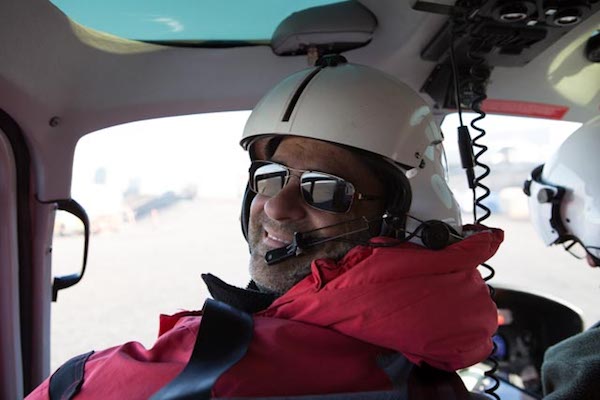 Matt in the front seat of the A-star 2. Touring the Icebreaker and Research vessels in Winter Quarter’s Bay!
This past few days we have seen the US Coast Guard Icebreaker Polar Star and the research vessel Nathaniel P. Palmer visit McMurdo Station, docking at the ice pier in Winter Quarter’s Bay. I had the opportunity to tour both. Amazing ships. The icebreaker has a tremendously powerful set of engines, and it actually goes up onto the ice and uses the weight of the ship to break the ice. A full channel has been cut in from the station including a turning basin to allow incoming ships to turn around, etc. The research vessel is a larger ship, with all sorts of lab space for scientists to do their work, etc. Overall, it was fun to see the view from the bridge of both vessels, and to have them both docked here at the ice pier.
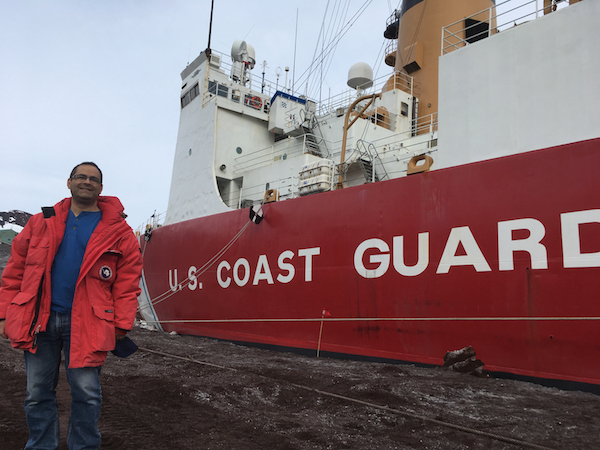 Matt with the US Coast Guard Icebreaker 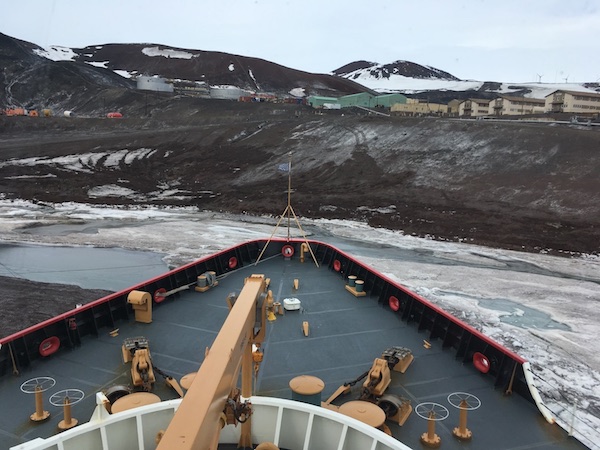 View from the Icebreaker bridge 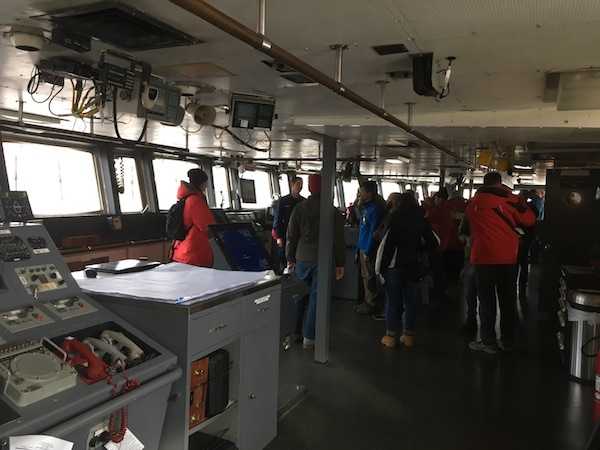 Icebreaker Bridge  View of Hut Point from the Icebreaker 3. Visiting Scott Base
On Sunday afternoon, we had the opportunity to visit Scott Base, which is New Zealand’s main station in Antarctica. It’s a short ride away – and a bit of a walk (less fun in the bad weather we had on Sunday). They have a small store you can visit, and nice view South, however it wasn’t to be seen the day we went due to the bad weather.
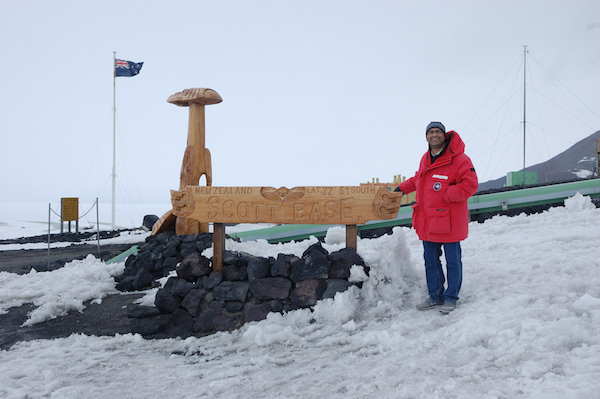
4. Snow! Weather delays
Weather has been terrible here for the last few days, making it difficult to fly any aircraft in or out. We actually had a 2 to 3 inch snow storm in the last 24 hours, along with fog and very low cloud ceilings. It was interesting to see the volcanic rock around McMurdo and Observation Hill all turn white with snow. We’ve been canceled for flying again today due to bad weather at the locations of our weather station sites.

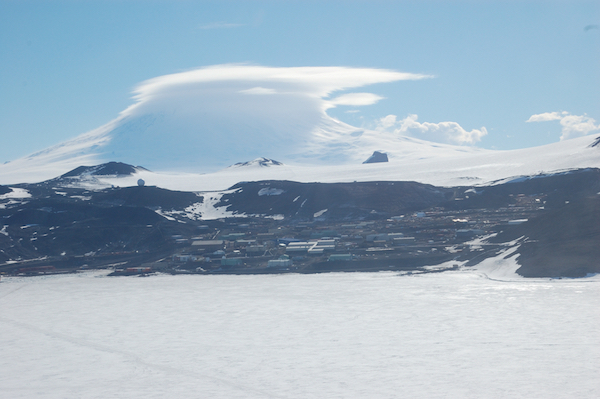 Lenticular Clouds around Mt. Erebus 5. Science Presentation: Fossils of Antarctica!
This past Sunday night’s science lecture was on fossils. Many have been found in Antarctica, and they are related to some of the same found in South Africa and other areas of the world. The science group giving the presentation are trying to learn about some of the past mass extinctions of species on the planet – especially during the very early Triassic period (if I have that right).
Until next time!
Matthew
Hello Everyone!
This week has been an ever increasingly busy week! So much to talk about:
First, I should make a note about the US Antarctic Program (USAP). It is overseen by the National Science Foundation (NSF). They oversee and fund the work that is done here. It’s a bit of a hefty job, but it includes many players: Military, University grantees/researchers, forecasters, contractors, and many, many others.
On Tuesday, I got to visit the Long Duration Balloon (LDB) facility that NASA (along with help from NSF), has out near Willie Field. This project launches payloads of science gear into the upper atmosphere to study all sorts of things via big, big balloons. It’s cheaper than launching a rocket and you can do some really need space science projects. They have their own weather forecasting operation there, and they do make use of our weather observations to support their forecasting activities. The ride out there, I got take a newer vehicle that they have here – a Kress. It was interesting. Bouncy – and unlike some other modes of transportation, very quiet inside. At the LDB facility I got to see the SuperTiger payload they have been trying launch. It got canceled this year due to stratospheric winds and the timeline on the season, but the project involves the study of very larger area, high resolution, trans-iron cosmic rays. Neat stuff in the space sciences. I got to see one of the vehicles they use to hold up the payload while the balloon inflates before launch. The tires are huge! I also got a few good photos of Mt. Erebus – the world’s southern most active volcano! You can see a steam plume from the top! (See the photo attached).
 SuperTiger2 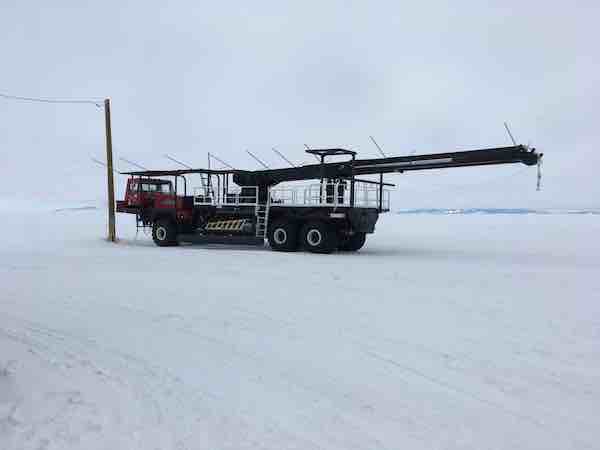 LDB vehicle for payload  Matthew and the LDM vechicle 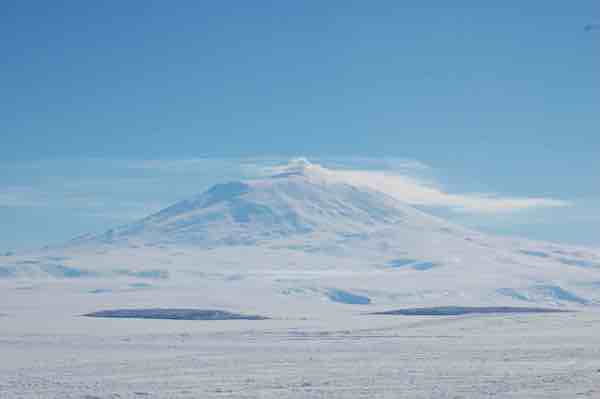 Mount Erebus On Wednesday evening, I gave the Science Lecture of the week. Funny, it coincided with when I would have started teaching! Sure enough, you can’t really take the teacher out of me! I was thrilled to have a packed room of over 50 or more scientists, Air National Guard, NASA, Weather forecasters, NSF, and station personnel attending. It was fun to talk about the weather station project, and the work we are doing. Some great questions were asked, and it was a rare chance to introduce all we do here in McMurdo. Folks keep talking with me about it – so that is good news. Glad everyone liked the presentation.
Finally, we got into the field! Yesterday, plans were to fly to Linda AWS via helicopter (helo), but it was canceled due to “flat light” conditions under solid cloud cover. Clouds make it so you cannot see the surface definition very well on the ice. It makes it very unsafe to land. So, we made lemonade out of the lemons we got, and drove out to Phoenix AWS. Phoenix AWS is at the USAP’s new airfield about 10 miles away from Ross Island. The older spot, Pegasus Field, has been closed due to melty surface conditions. We even had to remove our weather station there, as it could no longer be anchored well to the ice – it would melt out and fall over. Phoenix AWS was working until a few weeks back, so we checked into it, and it appeared to run for a few hours, but we’ll need to remove it and get into the lab here for testing. In my selfie you can see our AWS as well as other gear that is out there in use by a colleague of mine studying precipitation. I have photo of our station attached as well.
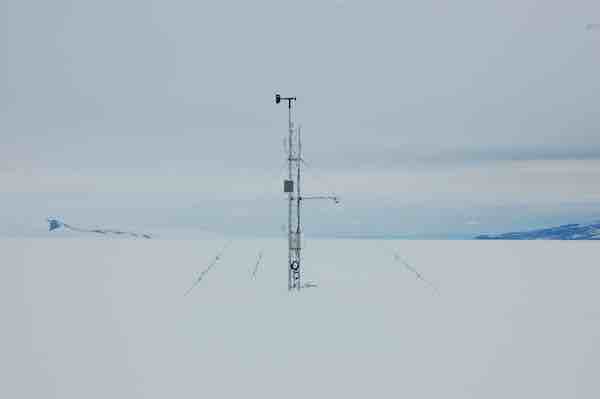 Phoenix AWS  Matthew and the suite of instruments at Phoenix AWS Today we hoped to fly again, but also the weather was not good. See the attached satellite image. Storm (marked with an L) on the ice shelf is making it hard to get out to the places we want to be.

The US Coast Guard Icebreaker has come into town and docked at the ice pier (see the photo attached). It will be here a few days before returning to cutting in a channel for the next supply and research vessels that will visit.
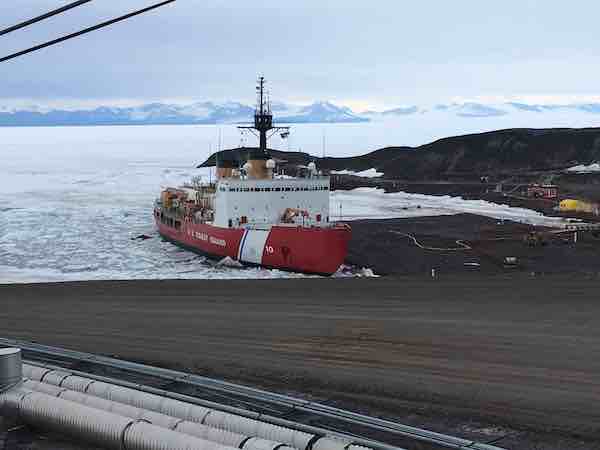 Icebreakk docked at the Pier Thanks everyone!
Cheers from McMurdo Station,
Matthew
Hello Everyone!
It has been a busy first few days here at McMurdo Station. Most of the time has been filled up with training (yes, training), meetings, and even a brief weekend break. We work 6-day weeks here, with Sunday off. (And even some science keeps going on Sundays). I’ve also been very fortunate to visit with colleagues I have not seen in some years who work very hard here at McMurdo Station to make all of the work we do possible.
First, before you can do any work out in the field, we must be trained on how to live, work, and operate all sorts of things both in McMurdo as well as out in the deep field. Hence, since arriving, we have completed the following training activities:
Light Vehicle Driver Training (and I had to do a driver’s test!)
Fire Safety
Waste Management
Medical
Environmental Awareness
Antarctic Field Safety
Outdoor Safety
Communications
Helicopter operations
Attached are photos of going through a full survival bag, so we know how to handle all of it. We practice lighting stoves, setting up tents, how to stay healthy and manage risks. Also, you can see, there is no “trash” here in Antarctica – but we do separation of all waste at source, with a 65% recycling rate. I think the US is half of that figure or so. And yes, when in the field, we bring EVERYTHING back…everything…for waste management and recycling. So, I will be bringing a Pee bottle with me on my day trips to work on the weather stations. Beyond this I had several planning meetings for planning our actual work. Now we start to dig into flying/driving places hopefully before the week is out! (Once things are scheduled)
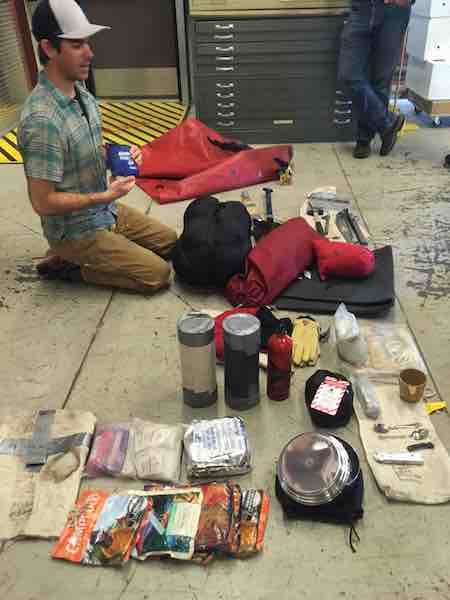 Contents of Survival Bag 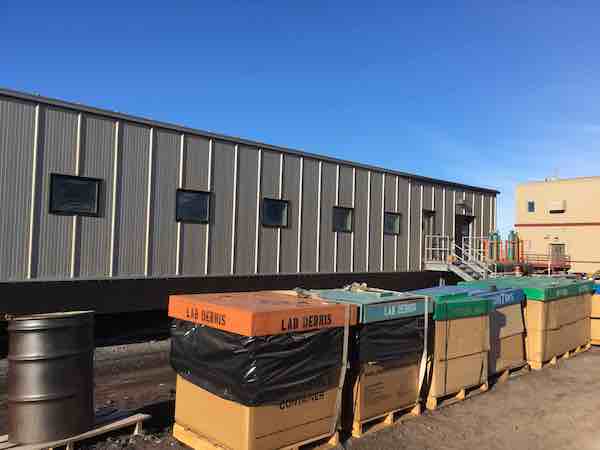 Waste bins outside of Crary 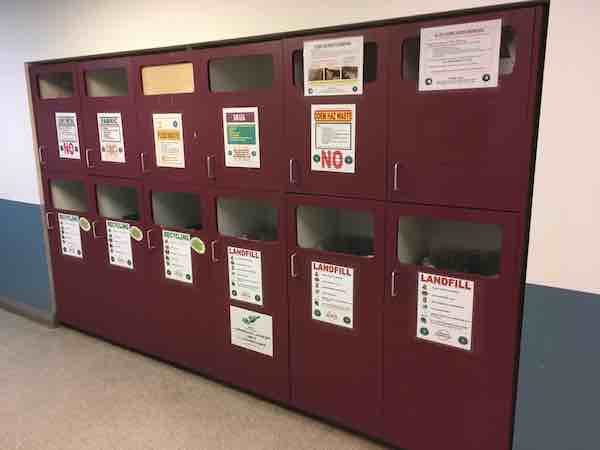 Waste bins inside the buildings This weekend, had a nice spot of weather with temperatures around 30°F, calm winds, and sunny skies. Hence, I got to walk out to Hut Point Peninsula – just next to the station. Here I was able to get photos of some seals, and yes, the US Coast Guard Icebreaker Polar Star has arrived! It is cutting a channel for resupply and research vessels to visit McMurdo station in the coming weeks. Also located here is Scott’s Hut – a hut built by Sir Robert Falcon Scott, during the heroic age of exploration of Antarctica. The hut is still here, and is now a protected area – you have to have a permit to enter the hut. Inside, you find all of the items Scott, and others who used the hut, left behind, as they left them (things really don’t degrade away here that much in Antarctica). Also in the background, you can see the “ice pier” (covered with the volcanic rock found here (there is no “dirt” here). The ships will be docking in what is known as Winter Quarter’s Bay – one of the southern most points in the world you can sail a ship. At the very tip of Hut Point is a cross in honor of George T. Vince – a member of Scott’s 1901 crew. He died falling off the “Danger Slopes” in a blizzard back in 1902, and slipped into the sea/ice below. The tip of the peninsula itself has now “calved” off into the ocean and made an even steeper cliff into the water below. Also in the photo is a view of McMurdo Station as it is today, as well as Observation Hill on the other side of the station.
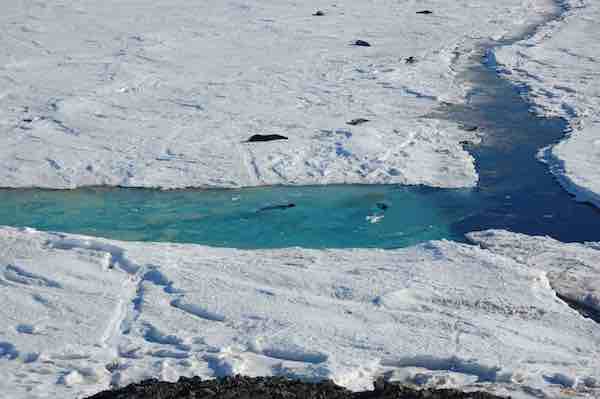 Seals!  US Coast Guard Icebreaker  Scott’s Hut  Vince’s Cross at Hut Point with Observation Hill and McMurdo in the backgroun There are a series of talks/presentations given here at McMurdo Station. One is the Sunday lecture. This lecture is attended by most folks on station. The largest spot is the galley where we have our meals. This week’s presentation was on some of the historical figures who explored the Antarctic – especially ones like Vince – who are not well known, but were a part of the early exploration and early science accomplished here in Antarctica. Folks such as Crozier, Vince, Ross, McMurdo were discussed. Many impressive folks that did great work that aren’t household names, and collectively paved the way for modern Antarctic science.
More later in the week!
Best Regards,
Matthew
Hello Everyone!
Greetings from Antarctica! I am happy to report I have successfully made to “the ice” (as we affectionately call Antarctica)! You can see me here in front of an LC-130 Hercules aircraft, flown by the 109th New York Air National Guard. We landed a William Field – a skiway here where you can land skied aircraft like the LC-130.
 Matt departing the LC-130 at Williams Field From what I can tell, I am lucky to have arrived. The flight before ours tried to get to Antarctica, but turned back due to mechanical issues. Coming back to Christchurch after trying to get to Antarctica is called a “boomerang”. They were supposed to be flying right behind our flight yesterday, but didn’t get to go again – I’m not sure 100% sure why. Today all flights in or out of McMurdo Station have been canceled due to fog in the area. So those folks have now been in Christchurch for over a week!! You can see some of the fog in the attached image I took as we flew over North Victoria Land. The sea ice over this section of the Ross Sea is also breaking out – after all it is summer time here. Temperatures have been a near constant 18°F or 19°F today with winds up to 30 mph.
 Fog over Victoria Land 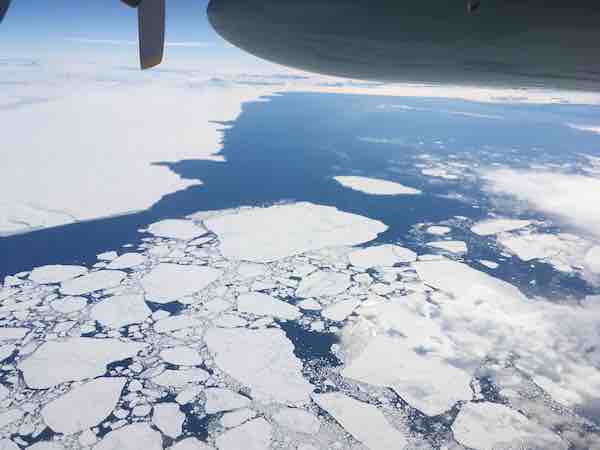 Sea ice viewed from the LC-130 For the next several days I will be doing training activities to be able to do the work I will be doing here, and to do so safely, etc. More on all of that in the near future!!
Cheers,
Matthew
Hello Everyone!
As promised, a bit more from around the City of Christchurch.
As can be seen through the city center, trams are about touring folks around the city. I have a nifty shot from the Art Center, which used to be the University of Canterbury. It is a famed location, as it is where Sir Ernest Rutherford studied before doing his famous work on the discoveries about the atom. The Arts Center is being rebuilt in places after the earthquakes. Another landmark is the Queen Victoria Clock Tower – built in honor of the Queen’s diamond jubilee. It also suffered damage in the earthquakes, but it has been restored. In another part of the city is the Bridge of Remembrance, originally to honor all of those from this region of New Zealand (Canterbury) during World War I. It has since been expanded to honor those from other events since the Great War.

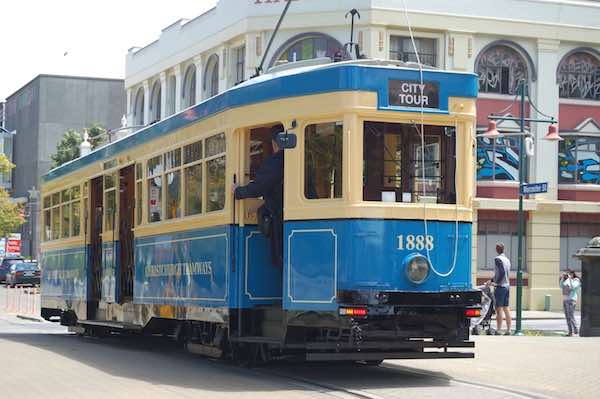
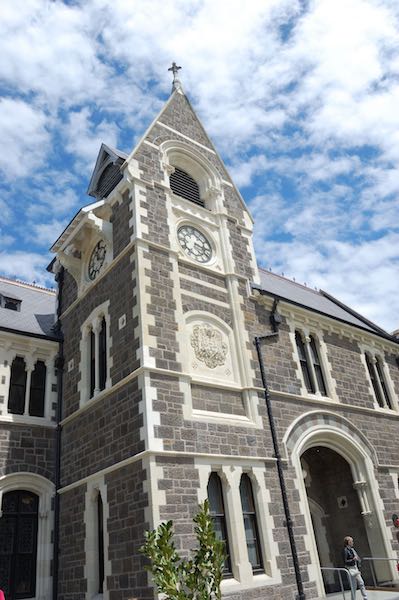 Art Center at the old University of Canterbury  Queen Victoria clock tower  Bridge of Remembrance 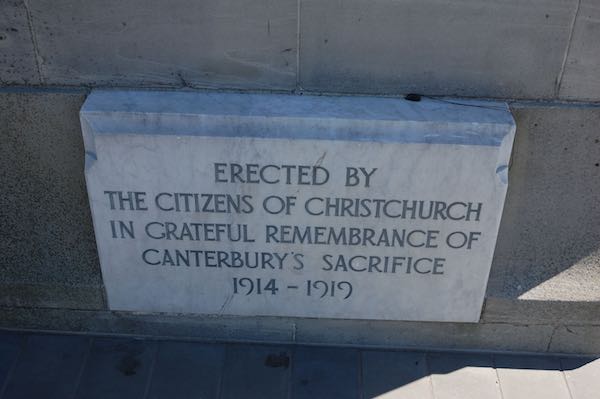 Plaque at the bottom of the Bridge of Remembrance Yesterday we had our issue of ECW or Extreme Cold Weather gear at the US Antarctic Program’s Clothing Distribution Center or CDC. It is located at the International Antarctic Centre here in Christchurch. We take roughly 35 to 70 lbs of ECW gear, depending on the job you are doing in Antarctica. Across from the Antarctic Centre is the where the US main hangar is for the aircraft operations that will be taking us south – hopefully later today! (We are currently on a four hour delay due to bad weather in McMurdo).
 Extreme Cold Weather (ECW) gear on display at the Clothing Distribution Center (CDC)  Antarctic Centre 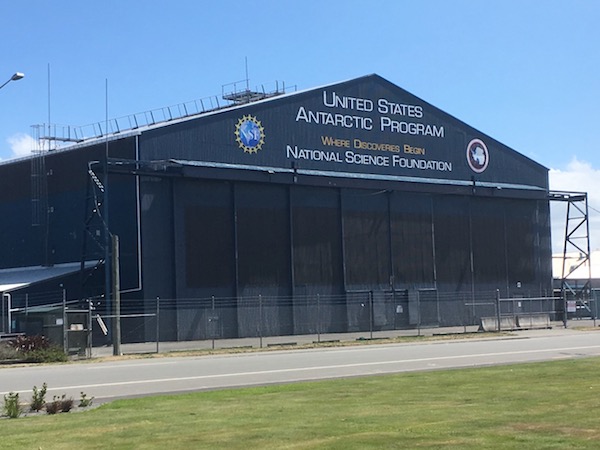 USAP-NSF-Hangar Cheers from Christchurch,
Matthew
|
|











































































